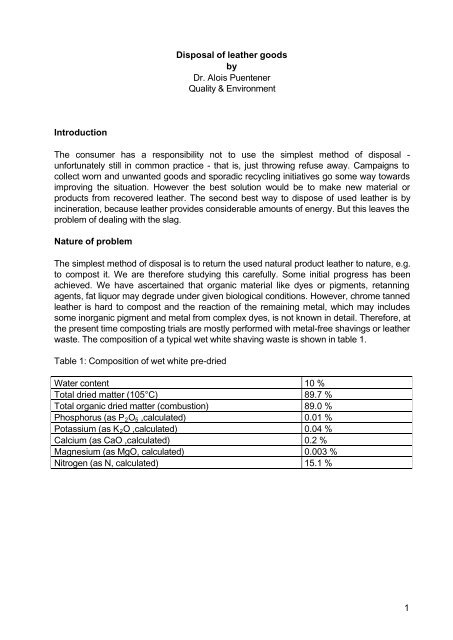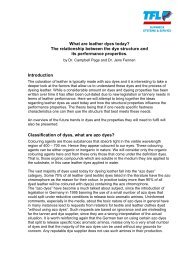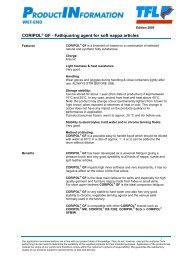Disposal of leather goods (pdf / 1434 KB) - TFL
Disposal of leather goods (pdf / 1434 KB) - TFL
Disposal of leather goods (pdf / 1434 KB) - TFL
Create successful ePaper yourself
Turn your PDF publications into a flip-book with our unique Google optimized e-Paper software.
Introduction<br />
<strong>Disposal</strong> <strong>of</strong> <strong>leather</strong> <strong>goods</strong><br />
by<br />
Dr. Alois Puentener<br />
Quality & Environment<br />
The consumer has a responsibility not to use the simplest method <strong>of</strong> disposal -<br />
unfortunately still in common practice - that is, just throwing refuse away. Campaigns to<br />
collect worn and unwanted <strong>goods</strong> and sporadic recycling initiatives go some way towards<br />
improving the situation. However the best solution would be to make new material or<br />
products from recovered <strong>leather</strong>. The second best way to dispose <strong>of</strong> used <strong>leather</strong> is by<br />
incineration, because <strong>leather</strong> provides considerable amounts <strong>of</strong> energy. But this leaves the<br />
problem <strong>of</strong> dealing with the slag.<br />
Nature <strong>of</strong> problem<br />
The simplest method <strong>of</strong> disposal is to return the used natural product <strong>leather</strong> to nature, e.g.<br />
to compost it. We are therefore studying this carefully. Some initial progress has been<br />
achieved. We have ascertained that organic material like dyes or pigments, retanning<br />
agents, fat liquor may degrade under given biological conditions. However, chrome tanned<br />
<strong>leather</strong> is hard to compost and the reaction <strong>of</strong> the remaining metal, which may includes<br />
some inorganic pigment and metal from complex dyes, is not known in detail. Therefore, at<br />
the present time composting trials are mostly performed with metal-free shavings or <strong>leather</strong><br />
waste. The composition <strong>of</strong> a typical wet white shaving waste is shown in table 1.<br />
Table 1: Composition <strong>of</strong> wet white pre-dried<br />
Water content 10 %<br />
Total dried matter (105°C) 89.7 %<br />
Total organic dried matter (combustion) 89.0 %<br />
Phosphorus (as P2O5 ,calculated) 0.01 %<br />
Potassium (as K2O ,calculated) 0.04 %<br />
Calcium (as CaO ,calculated) 0.2 %<br />
Magnesium (as MgO, calculated) 0.003 %<br />
Nitrogen (as N, calculated) 15.1 %<br />
1






